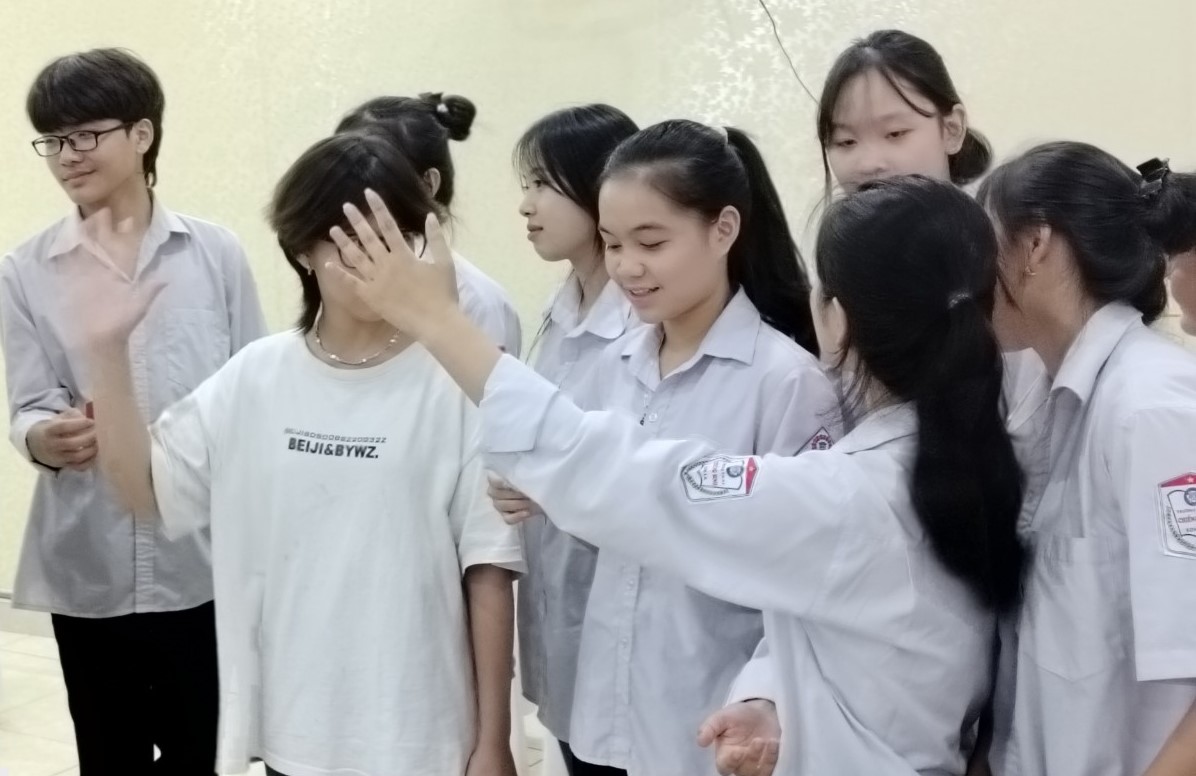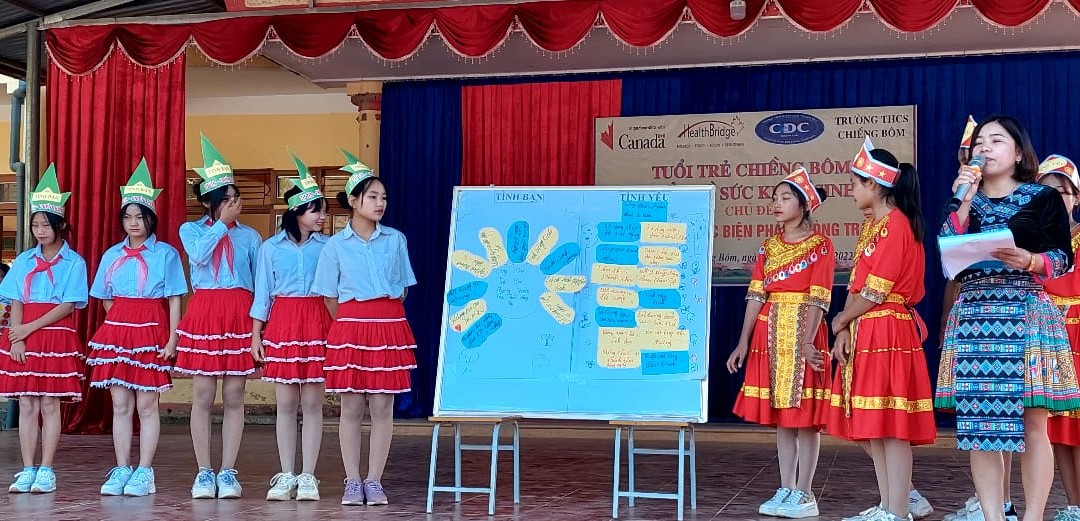Lessons in puberty: Adolescents in Vietnam and Nepal learn about sexuality in skits, competitions

Sexual and reproductive health education is an important, but sensitive, topic for Tram, 15, a student at Nguyen Trai Secondary School in Vietnam’s Son La province. She’s curious about her body and wants to know more about the changes she’s going through as an adolescent. But Tram is unsure if what she reads online is true and she’s afraid to approach her mother or teacher for information on this delicate matter.

Photo Credit: HealthBridge
When the school, in the mountainous northwest region of the country, organized a mass-education event on sexual and reproductive health last year, Tram played a character in a performance that put many of her questions and fears to rest. “Through the skit, I learned a lot for myself,” says Tram.
The role-playing activity, in which a group acted out a visit to a family-planning clinic, taught her how to deal with difficult social situations she might face. The information, shared through interactive exercises and competitions, also made her realize that reproductive and sexual health education is crucial to young people. “It is important to learn about this — and especially at school,” says Tram.
The event is part of programming to bring comprehensive sexuality education (CSE) and sexual and reproductive health services to teens in remote areas of Vietnam and in Nepal. Supported by Global Affairs Canada through the HealthBridge Foundation of Canada and implemented by HealthBridge and local partners on the ground, the initiative aims to improve reproductive health and gender equality among girls and women in marginalized communities.

Photo Credit: HealthBridge
“We want adolescents to have confidence about their sexual knowledge,” says Huan Nguyen Van, project manager for HealthBridge in Vietnam. He says the project includes engaging with local community leaders and health providers to promote the quality of sexual and reproductive health services and their use by girls and women. In schools, it helps develop curriculum and train teachers and student facilitators to advance sexual and reproductive health education. It reaches out to community groups, health workers and volunteers as well as religious leaders to tackle cultural norms that can lead to gender-based violence, such as child marriage.
“We want communities to support youth with their decisions and offer sexual and reproductive health services that are friendly,” Huan explains. “Young people should not feel shy when they go to the pharmacy to buy condoms, for example. It should be normal.”
Carried out in collaboration with the Center for Disease Control of Son La in Vietnam, the project is focused on 3 secondary schools with students 12 to 15 years old and 3 high schools with students 16 to 18 years old.

Photo Credit: HealthBridge
Huan says that Vietnam’s General Office for Population and Family Planning reports that the abortion rate among adolescents and young adults in the country is increasing and accounts for more than 20% of all abortions. And he notes that the rates of adolescent abortion, early marriage, teenage mothers and maternal mortality in Son La are significantly higher than the national average.
He says the Government of Vietnam is moving to implement CSE nationwide, and the HealthBridge program helps by providing intensive teacher training on the topic. It gives teachers communication skills and tools to deliver the material in interactive ways such as group work, modelling, flip charts, PowerPoint presentations and coaching.
Luong Huu Hung, a biology teacher at Chieng Sinh High School in Son La, says that “if students are equipped with reproductive and sexual health knowledge, they will know how to protect themselves and apply this knowledge in their lives.” He’s concerned that while CSE is part of subjects such as biology, civic education and career orientation, “the amount of knowledge included is not much.” And students may choose not to take those courses as part of their education.

Photo Credit: HealthBridge
Hung would like the school to set up a “youth-friendly corner” on sexual and reproductive health that teens can visit and read useful information about the topic. And he wants to see more mass-education activities “so that all students can have a chance to join.”
The events include skits in which young people act out situations they are likely to encounter in everyday life and sessions to discuss topics such as the difference between friendship and love. There are contests where teams gain knowledge about physical changes during puberty or are quizzed on the different methods of birth control. Students receive a certificate of completion for the training course on adolescent sexual and reproductive health.

Photo Credit: HealthBridge
Similar programming is also underway in Nepal, where HealthBridge works with the International Nepal Fellowship (INF) to offer CSE teacher training and interactive student activities in the country’s rural Kalikot district. Padma Hitan, a project officer for INF, says this region, in the Himalayan part of Nepal, is economically disadvantaged, isolated and conservative. For instance, chaupadi, the segregation of girls and women who are menstruating, is practised widely.
The CSE project is being delivered in 11 schools in Nepal. It helps students understand and cope with the physical, psychological and emotional changes that come with puberty, says Hitan. “They feel shy to share their feelings about these changes with their friends as well as their parents.”
The students enthusiastically participate in CSE activities such as dramas, where they act out the challenging consequences of getting married too young, Hitan says. “They learn that when they don't get married at an early age, then they will be able to continue their education and they can be independent.”
Chandra Prasad Koirala, an English teacher and principal of Shree Panchadev Secondary School in Kalikot, has received CSE training through the project. He talks to students about concepts like speaking up when they are in uncomfortable situations. He demonstrates that each person has a “comfort zone” and talks about the principles of “good touch, bad touch,” as well as how to set boundaries.
Lessons in the emotional, physical and social aspects of sexuality are critical for teens, comments Koirala. “There are lots of changes happening during adolescence,” he says. “If we can raise awareness related to child marriage and family planning to these adolescents, they might be able to cope with these issues.”

Photo Credit: HealthBridge
Kishwor, 16, a student at the school, feels the sessions “are very important for us because a lot of students are not aware of sexuality.” Kishwor, who plans to study agriculture so he can help farmers in his region produce sufficient food, would like to see CSE integrated into extracurricular events in which the students take part on Fridays. “It is helpful to know more about issues we commonly face during adolescence,” he says.
In Vietnam, Tram hopes to see the mass-education events on sexual and reproductive health expand to include more skits and additional elements like drawing as well as making videos. “This would increase the excitement and attraction to students,” she says.
Participating in such activities “can help us be fully equipped for life,” says Tram, who is studying hard to become a doctor so she can contribute to her community by providing treatment and care to people there.
- Date modified: